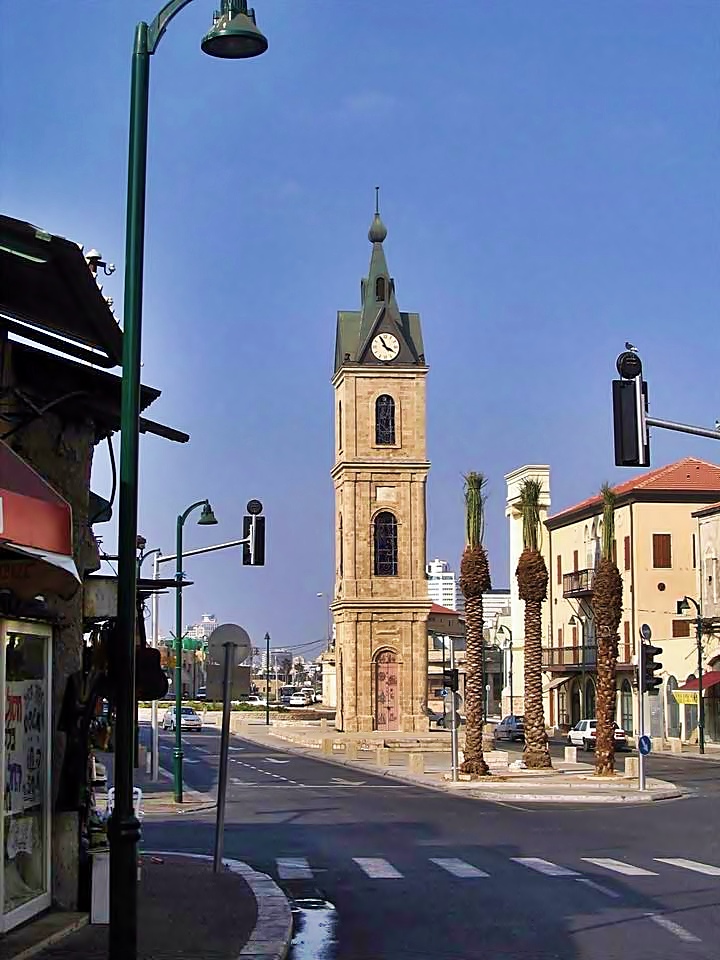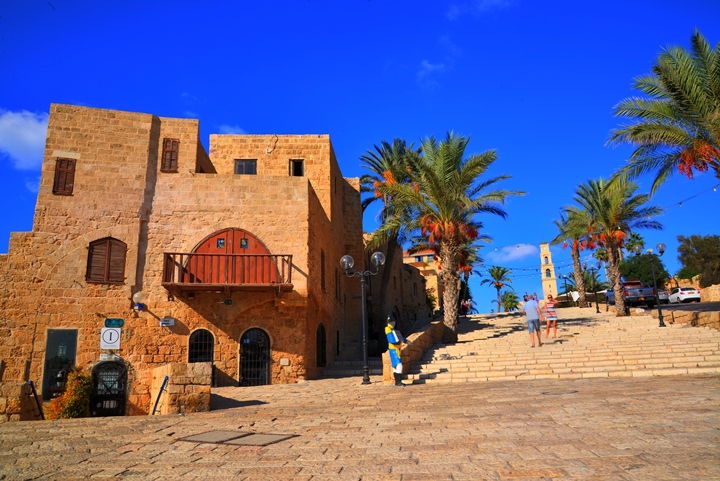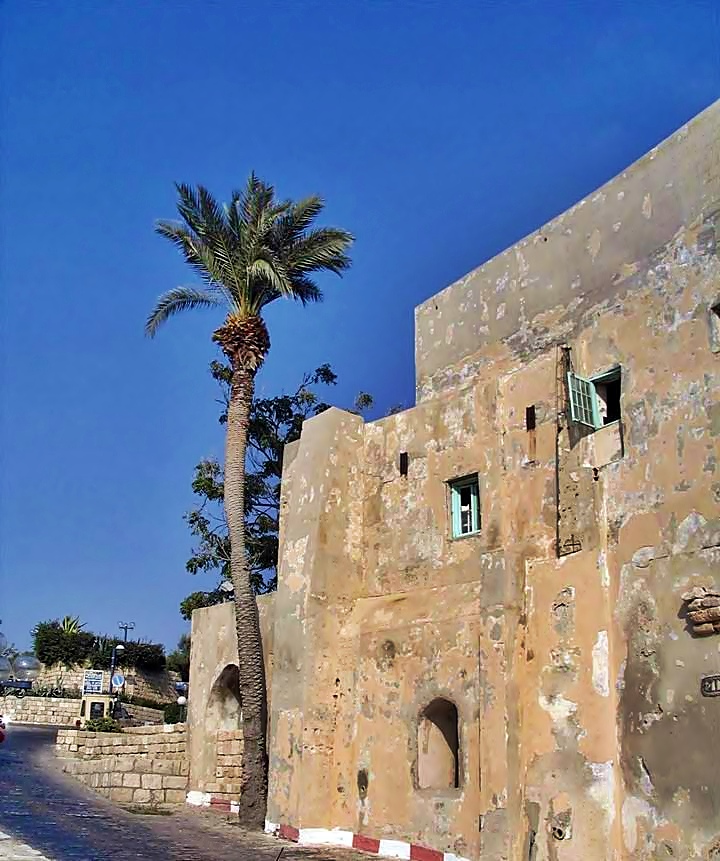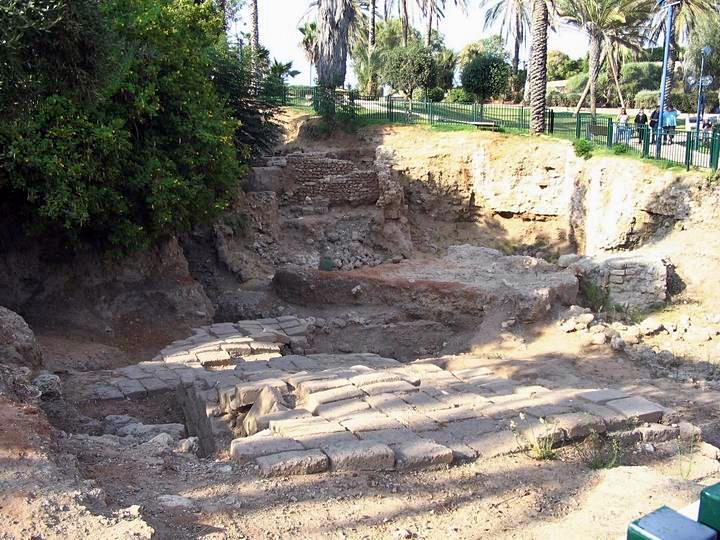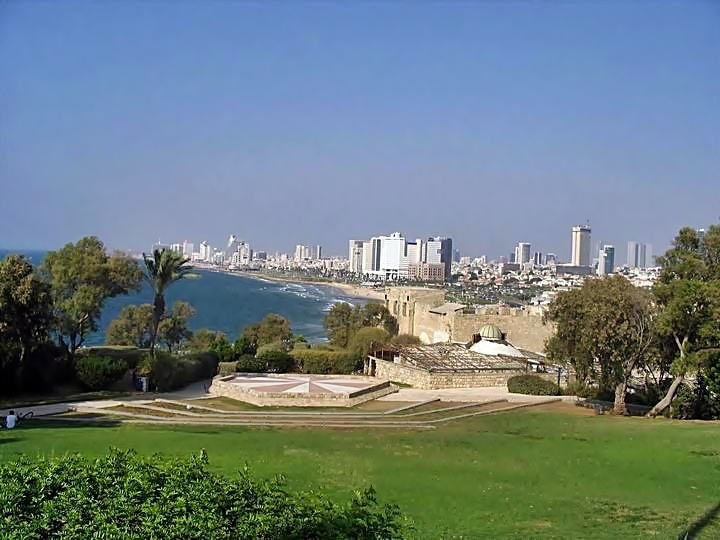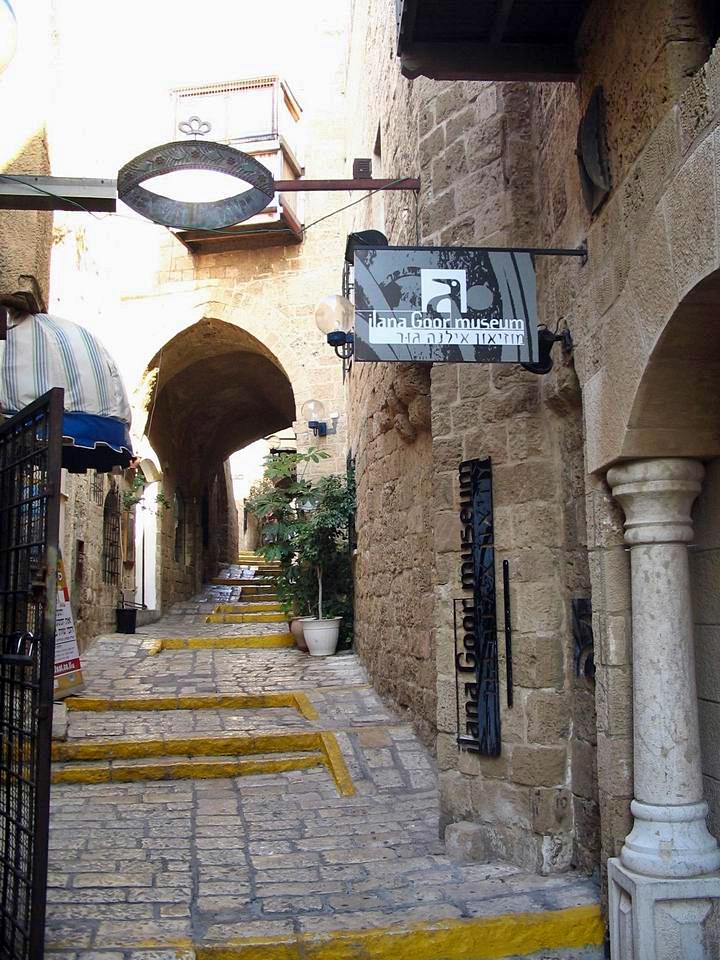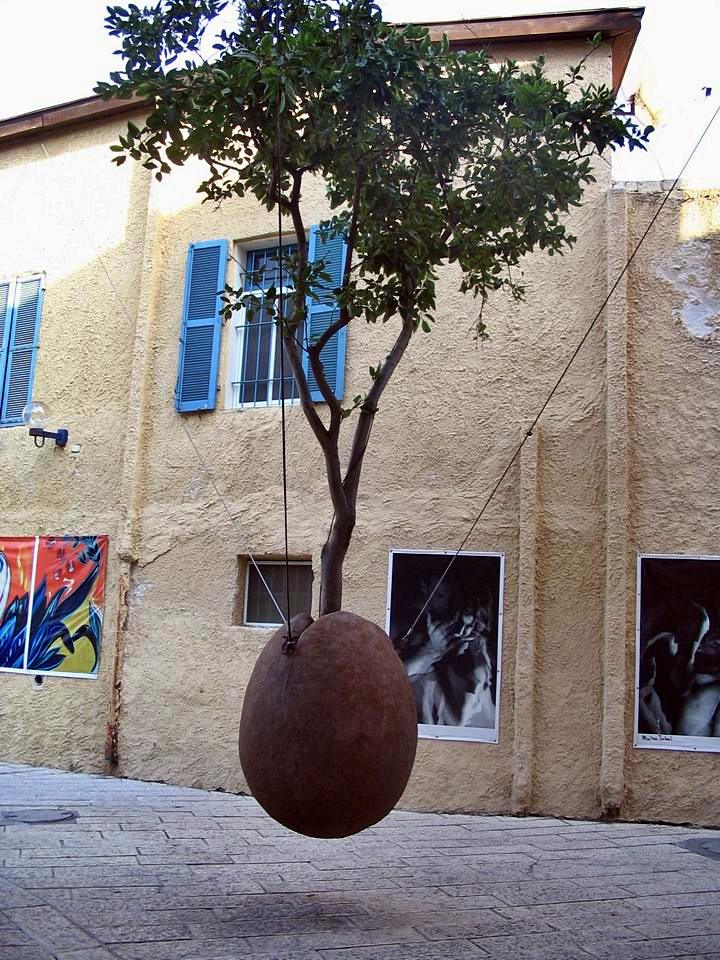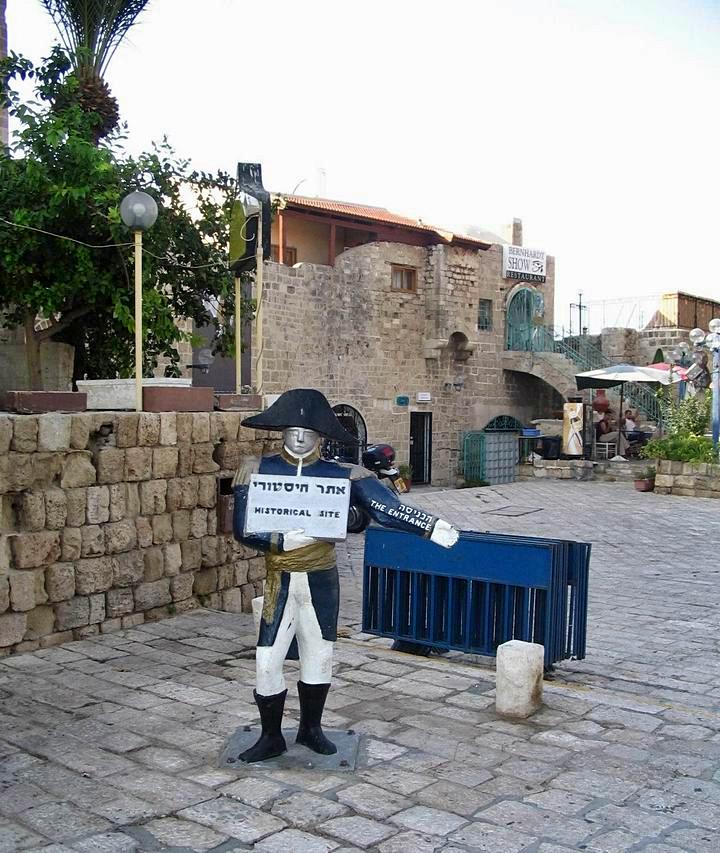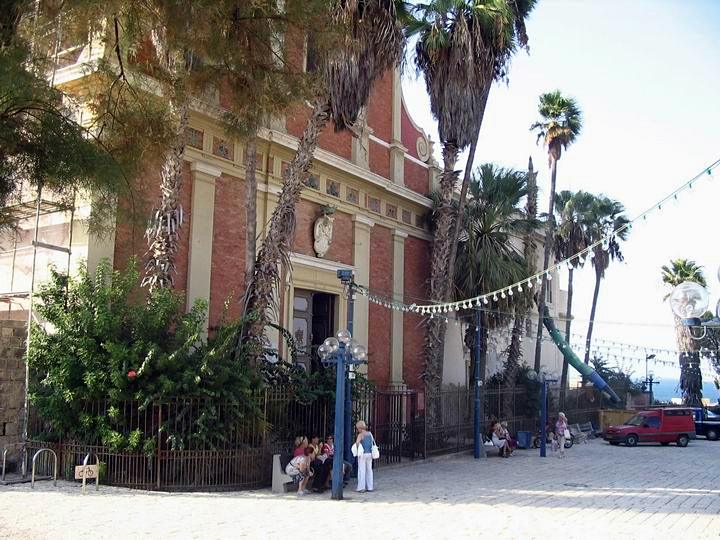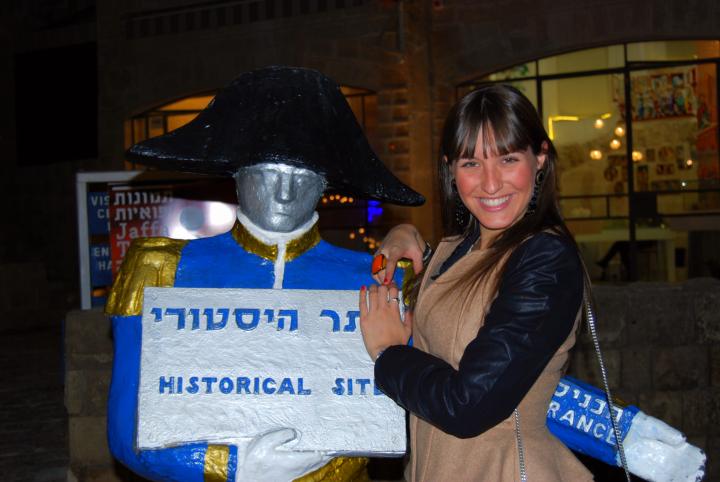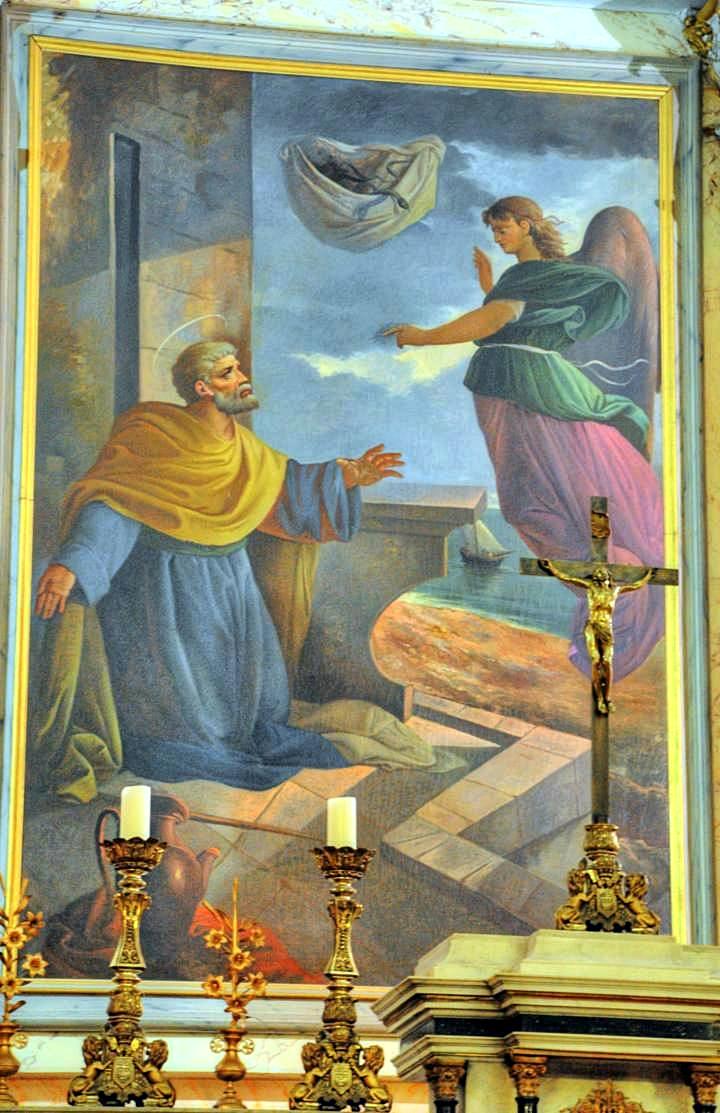One of the most important port cities in ancient history, strategically located at major crossroads in the center of the land of Israel.
* Site of the Month Mar 2012 *
Home > Sites > Sharon > Jaffa (Joppa, Yafo) – Overview page
Contents:
Overview
Location
History
Photos
* Lower city
* Old city
* Artists shops
* Museum
* Port
* Churches
* Summary
Biblical
Etymology
Links
Power Point shows
Overview:
Jaffa (Joppa, Yafo) is an ancient city located on the Mediterranean coast of Israel, just south of Tel Aviv. It is one of the oldest port cities in the world, with a history that dates back over 4,000 years. Due to its natural advantages, a hill above a bay, and its strategic location on the crossroads of Israel, the city was a center of historical events over thousands of years.
2 Chronicles 2:16: “And we will cut wood out of Lebanon, as much as thou shalt need: and we will bring it to thee in floats by sea to Joppa; and thou shalt carry it up to Jerusalem”.
Jaffa has been inhabited by many different civilizations throughout its long history, including the Canaanites, Egyptians, Greeks, Romans, Crusaders, Ottomans, and British. As a result, the city is home to a rich tapestry of archaeological and historical sites, including ancient fortifications, religious buildings, and residential neighborhoods.
Some of the most notable landmarks in Jaffa include:
- Jaffa Port – one of the oldest and busiest ports in the world, with a history dating back to ancient times.
- St. Peter’s Church – a beautiful Franciscan church located on the site where, according to tradition, St. Peter had a vision of the animals descending from heaven.
- The Jaffa Flea Market – a bustling marketplace that has been operating for over 100 years and offers a wide range of goods, including antiques, crafts, and fresh produce.
- The Clock Tower – a prominent landmark located in the center of Jaffa’s old city that was built in the early 20th century.
- The Jaffa Museum of Antiquities – a museum that showcases the rich history of Jaffa through a collection of artifacts and exhibits from different periods.
Today, Jaffa is a popular destination for tourists and locals alike, offering a unique blend of ancient history, cultural diversity, and modern amenities.
This is an overview page, with links to the Jaffa sites reviewed in BibleWalks.com.
Location:
A map of the old city of Jaffa, with indication of some of its major points of interest, is shown in the aerial view below.
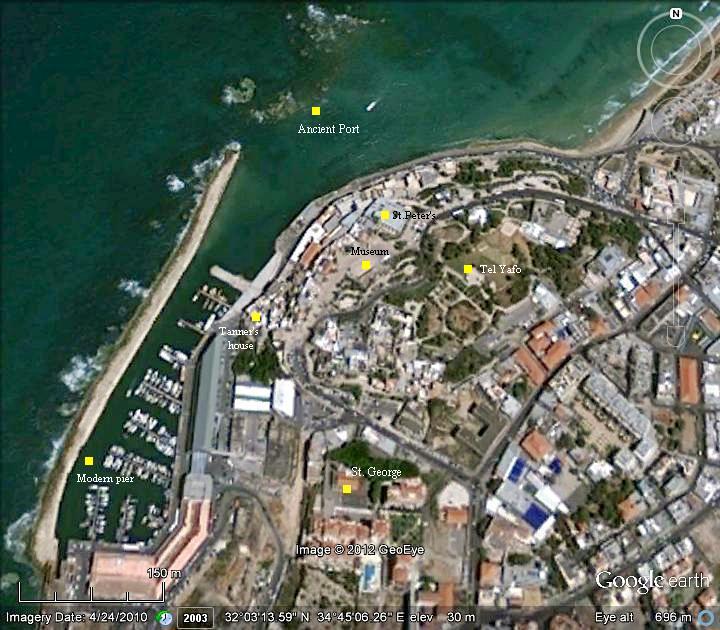
History:
- Canaanite Period – Middle Bronze age (20th – 12th century BC)
The natural harbor of Jaffa, located near a defendable hill, was in use in the Middle Bronze age, some 4,000 years ago. The Canaanite seaport city became an important stronghold with the valuable access to the Mediterranean sea.
Jaffa is strategically located in the center of Israel, near the north-south Via Maris (“Way of the Sea”) – the ancient coastal road that connected the regions north of Israel (Mesopotamia, Asia minor and Syria) to the south (Egypt). The cities and roads during the Canaanite, Israelite and Hellenistic/Roman periods are indicated on the Biblical Map below, with Jaffa (Joppa) in the center along the coast.
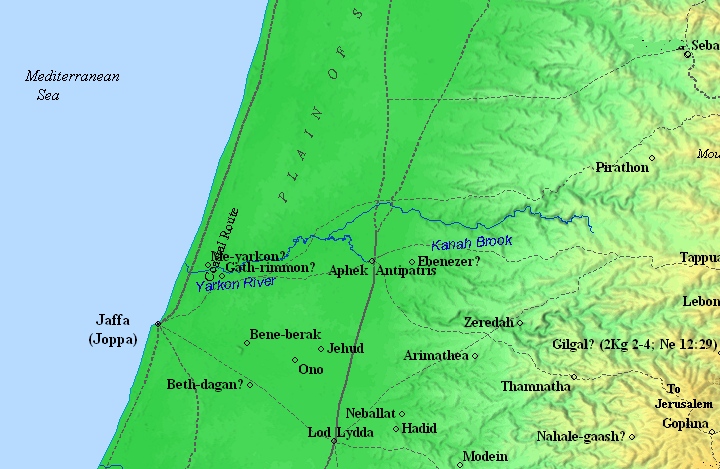
Map of the area around Jaffa/Joppa – 15th century BC through 1st century AD (based on Bible Mapper 3.0)
-
Egyptians rule (15th – 13th century BC)
When the Egyptians invaded to Canaan in the 15th century BC, one of their prime targets was Jaffa, a walled city with a maritime link to their main cities and access to the heart of the land. Its location south of a natural defense line (the course of the Yarkon river) made it a perfect front station to defend Egypt from the threats of the rising forces of Asia Minor and Mesopotamia.
The city is one of the cities that were conquered by Egyptian Pharaoh Thutmose III , just before the famous battle near Megiddo (1468 BC), which resulted in the Egyptian conquest of Canaan for 350 years. It is listed in his palace among the cities he conquered. The mighty city was captured only by trickery, as detailed in the accounts of the Egyptian commander. It is also mentioned in the El-Amarna letters, a 14th century BC Egyptian archive of clay tablets, which include letters written by Egyptian governors in Canaan. Jaffa was, according to these correspondences, an Egyptian administrative center and military base. A fortress, dated to Thutmose III, was excavated in Tel Jaffa.
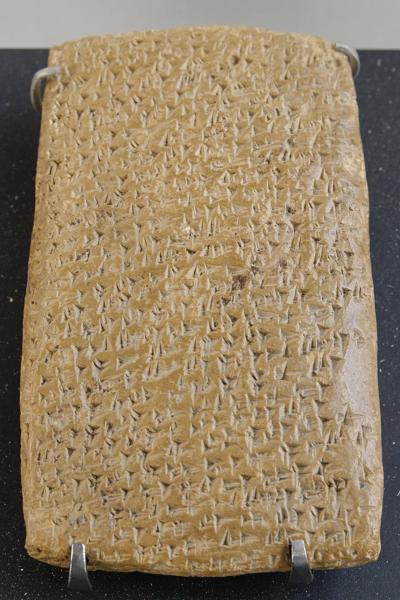
One of Tell Amarna letters (Louvre Museum, Public domain CC 2.5)
Cuneiform writing on a clay tablet.
Egyptian scarabs – seals or small good luck charms (nicknamed “Harpushit” since they look like beetles) were found in the excavations of Jaffa bearing the names of Amenhotep III and his wife Tiy(reign 1391-1353 or 1388-1351 BC). These findings indicate the high role of Jaffa within the Egyptian administration.
Ramses II:
At about 1300 BC the Hittite empire from Asia Minor pushed south into Syria and Canaan, threatening the Egyptians who controlled these land. The Egyptians tried to block the Hittites and engaged in a a series of battles. This threat increased the importance of Jaffa.
The climax of the Hittite-Egyptian wars came in the battle of Kedesh in Syria (1274 BC) during the reign of Egyptian Pharaoh Ramses II. The treaty of Kedesh, which is the earliest documented peace agreement, finally brought peace to the region (see photo on the right). Archaeological evidence found in the excavations of Jaffa, as well as other Egyptian documents, are dated to the reign of Ramses II (1279-1213 BC). The lintels of the gate, bearing the titles of Ramses II, were unearthed in Jaffa.
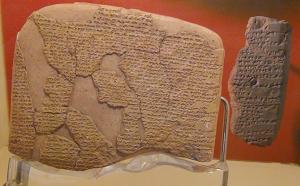
Kedesh peace treaty, 1274 BC
[Istanbul Archaeological Museum]
Some scholars date the Exodus of the Israelites from Egypt to Canaan during the reign of Ramses II. The Israelites, lead by Moses, decided to take a long detour through the desert rather than taking the short path along the coastal road, later known as the way of the Philistines. The existence of strong Egyptian cities along the coast, such as Jaffa and Gaza, were one of the reasons for this detour, as explained by the Bible (Exodus 13 17-18):
“And it came to pass, when Pharaoh had let the people go, that God led them not through the way of the land of the Philistines, although that was near; for God said, Lest peradventure the people repent when they see war, and they return to Egypt. But God led the people about, through the way of the wilderness of the Red sea: and the children of Israel went up harnessed out of the land of Egypt”.
The Philistines, the “Sea Peoples” from the Aegean sea, landed in Canaan and Egypt in the 12th century BC. The Egyptians fought the invaders (Ramses III battle of 1175 BC) and repulsed them into a small enclave in the southern coastal cities of Canaan (from Gaza to Ashkelon). At a later stage the Philistines moved northwards until the Yarkon river north of Jaffa. They replaced the Egyptians, ruling Jaffa until King Solomon’s times (1000 BC). The Philistines became the arch enemies of the Israelites until the 8th century BC.
- Judges (12th-11th century BC) – Tribe of Dan
After the conquest of Israel by Joshua, Jaffa was a border city in the region of the tribe of Dan (Joshua 19 39, 46): “This is the inheritance of the tribe of the children of Naphtali according to their families, the cities and their villages…. And Mejarkon, and Rakkon, with the border before Japho“. At that time the Israelites have not yet settled in the city. Later, the tribe of Dan used the port of Jaffa for marine trade, as hinted in judge Deborah’s complaint that Dan did not come to assist the campaign against the Canaanites (Judges 5 19): “and why did Dan remain in ships?”.
- King Solomon’s port (11th century BC)
The Israelites took control of the city only at later times, probably during Solomon’s period.
The port of Jaffa (Joppa) was used by King Solomon for importing wood in order to build the first temple in Jerusalem (2 Chronicles 2 1,8,16): “And Solomon determined to build an house for the name of the LORD, and an house for his kingdom… And Solomon sent to Huram the king of Tyre, saying,… Send me also cedar trees, fir trees, and algum trees, out of Lebanon… And we will cut wood out of Lebanon, as much as thou shalt need: and we will bring it to thee in floats by sea to Joppa; and thou shalt carry it up to Jerusalem”.
As seen on the illustration, the cedar wood logs were cut in the Lebanon and transported by boats to Jaffa. Then they were hauled to Jerusalem (70km to the east) to build the temple.
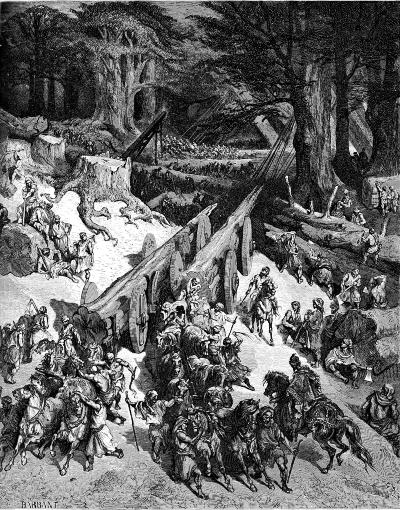
Cutting Cedar of Lebanon for Solomon’s temple
Drawing by Gustav Dore (French artist, 1832-1883)
- Jonah the prophet (8th century BC)
The port of Jaffa is also mentioned in the story of Jonah, the son of Amittai, who was commanded to carry the words of the Lord in the city of Nineveh, but refused and tried to escape to Tarshish (Jonah 1 3): “But Jonah rose up to flee unto Tarshish from the presence of the LORD, and went down to Joppa; and he found a ship going to Tarshish: so he paid the fare thereof, and went down into it, to go with them unto Tarshish from the presence of the LORD”.
A great storm threatened the safety of the ship, and the mariners threw him overboard, an he was swallowed by a whale (1 19): “And Jonah was in the belly of the fish three days and three nights”. Eventually, Jonah agreed to do as commanded by the Lord, so he was “vomited out upon dry land”, and then went to Nineveh to complete the mission.
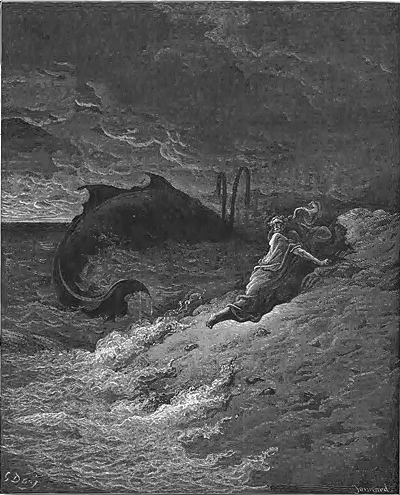
Jonah cast overboard to the whale – by Gustav Dore (French artist, 1832-1883)
-
Hezekiah and Sennacherib (701 BC)
In 701 BC the Assyrians, headed by Sennacherib (ruled 704-681), invaded Israel in order to subdue it to their vast empire. The Assyrian army was led by Sennacherib, son of Sargon II (2 Chronicles 32 1): “After these things, and the establishment thereof, Sennacherib king of Assyria came, and entered into Judah, and encamped against the fenced cities, and thought to win them for himself”.
In preparation for the war, Hezekiah, king of Judah,
enlarged the borders of the Kingdom (705BC to 701BC), and fortified the cities in Judea. This also the conquest and fortification of of Jaffa, which may have still been at that time a Canaanite seaport city.
However, Hezekiah’s actions were not sufficient to block the Assyrian assault: Sennacherib captured dozens of cities and villages and sacked some of them. (Isaiah 36 1): “Now it came to pass in the fourteenth year of king Hezekiah, that Sennacherib king of Assyria came up against all the defenced cities of Judah, and took them.” The city of Jaffa was also besieged.

Sennacherib’s stele with relief and inscription; Ninveh;
limestone [Istanbul Archaeological Museum]
-
Persian rule – Return to Zion (5th century BC)
After the return to Zion, the Persians allowed the returnees to rebuild the temple. As in Solomon’s times, the timber was transported through the port of Jaffa (Ezra 3 7): “They gave money also unto the masons, and to the carpenters; and meat, and drink, and oil, unto them of Zidon, and to them of Tyre, to bring cedar trees from Lebanon to the sea of Joppa, according to the grant that they had of Cyrus king of Persia”.
The port cities along the coast, including Jaffa, were governed by the Phoenicians from Tyre and Sidon, who were the great mariners of the ancient world.
-
Hellenistic period (4th -1st century BC) – Greek Mythology
Jaffa became a major Greek city starting at the end of the 4th century, after Alexander’s conquests. After Alexander’s death, the city was besieged and captured (315 BC) by Antigonus, one of Alexander’s general. The port city was renamed “Joppa” – which was also the name of the Greek Goddess Joppa – daughter of Aeolus the God of Wind. The Greeks also associated Joppa with one of the Greek Mythologies – Andromeda and Perseus.
According to the legend, Andromeda was the daughter of Queen Cassiopeia and King Cephus of Æthiopia (Africa). The beautiful Queen boasted the she and her daughter were more beautiful than the 50 sea nymphs (Nereids). The nymphs complained to the sea god Poseidon, who in turn avenged this insult by flooding the land, and sending a sea monster to devastate the kingdom. In order to stop this devastation, Andromeda was sacrificed to the beast by chaining her to a rock at the foot of a cliff, which many placed it in the bay of Jaffa. Perseus (the son of Zeus and Danae) flew by the cliff on his winged sandals, and fell in love with the beautiful princess. The young hero had just returned from the brave mission to cut the head of the Medusa – a terrifying female creature who had the power of turning living things to stone by a direct glance into her eyes. Perseus defeated the sea beast by using the Medusa’s head, turning it to stone. This earned him the consent of Zeus – the king of Greek Gods – to marry Andromeda, and the happy couple settled in Tiryns (in the Peloponnese).
Andromeda and Peruses were also commemorated by two adjacent star constellations. You can look for the beautiful Andromeda either in the sky during the night, or by coming to see the cliff of Andromeda (and the sea beast who was turned to stone) in the bay of Jaffa.
Joppa was captured by Ptolemy I (Greek ruler of Egypt) in 301 BC. It later fell under the rule of the Seleucids (Greeks of Syria) in 200 BC.
-
Hasmonean /Hellenistic period
The Maccabees defeated the Greek Seleucids and created an independent Jewish country – the Hasmonean Kingdom. The Greeks of Joppa avenged the defeat by drowning 200 Jews (163 BC), and so Judas Maccabee burnt their port (2 Maccabee 12 3-6):
“The men of Joppa also did such an ungodly deed: they prayed the Jews that dwelt among them to go with their wives and children into the boats which they had prepared, as though they had meant them no hurt. Who accepted of it according to the common decree of the city, as being desirous to live in peace, and suspecting nothing: but when they were gone forth into the deep, they drowned no less than two hundred of them. When Judas heard of this cruelty done unto his countrymen, he commanded those that were with him to make them ready. And calling upon God the righteous Judge, he came against those murderers of his brethren, and burnt the haven by night, and set the boats on fire, and those that fled thither he slew”.
During their expansions at the middle of the 2nd century BC, the Hasmoneans conquered Joppa and its port (147 BC). The control of the city was both commercially beneficial, as the marine commerce brought in much income, but also due to the strong presence of the Greek population in Joppa.
- Early Roman (1st century BC- 1st century AD)
Pompey conquered the land in 63 BC, and removed Joppa and the coastal cities from the area of the Jewish state as part of his territorial reforms (63 BC to 55 BC). Herod the Great conquered Jaffa in 39BC, reclaiming the port city to the Kingdom, thus providing access to the sea. Cleopatra and Mark Anthony annexed Jaffa in 32 BC, but Julius Caesar defeated the pair (30 BC), and the Roman emperor granted Herod the city (30 BC). For Herod the port of Jaffa was an important source of income, which enabled him to expand the Jewish kingdom, and helped to finance the construction of a modern port city of Caesarea (25-13 BC), which was a strong competitor for the port of Jaffa.
Jaffa continued to be part of the Jewish Kingdom under the Roman control.
The city is mentioned in the accounts of the early missionary journey of St. Peter.
Peter (“rock”) was one of the 12 apostles of Jesus. He is regarded as the most important and spokesman of the Apostles, and considered as the first Pope.
Peter resided in Jaffa/Joppa for some time in the house of the tanner, by the sea (Acts 10 5): “And now send men to Joppa, and call for one Simon, whose surname is Peter: He lodgeth with one Simon a tanner, whose house is by the sea side”.

Illustration of St. Peter’s – detail of picture in St. Peter’s Church, Jaffa
Revolt against the Romans:
During the great revolt against the Romans, there were fierce battles in the port (66 AD), and Jewish rebels attacked Roman vessels. The Romans, commanded by Cestius Gallus, attacked the city from the land and the sea, and burnt it.
Josephus Flavius wrote about the geography of the port and its fate (Wars 3 9 3-4): “Now Joppa is not naturally a haven, for it ends in a rough shore, where all the rest of it is straight, but the two ends bend towards each other, where there are deep precipices, and great stones that jut out into the sea, and where the chains wherewith Andromeda was bound have left their footsteps, which attest to the antiquity of that fable. But the north wind opposes and beats upon the shore, and dashes mighty waves against the rocks which receive them, and renders the haven more dangerous than the country they had deserted”.
He continued to describe the destruction: “…the number of the bodies that were thus thrown out of the sea was four thousand and two hundred. The Romans also took the city without opposition, and utterly demolished it”.
The city was later renamed “Joppa Flavius”, honoring the emperor Vespasian Flavius who crushed the mutiny and later rebuilt the city.
Roman soldier – in Jaffa museum
- Byzantine period (4th – 7th century AD), Arab period (7th -12th century AD)
The port city of Jaffa gradually became a small town during the Byzantine period, serving as a seaport for the Christian pilgrims. After the Arab conquest of Jaffa (636 AD) the port serviced the regional capital of Ramlah.
- Crusaders (1099-1291)
Jaffa returned to play an important role as a port city during the Crusaders period, giving them a maritime access to Jerusalem, and a logistic link to Europe. The Holy Land Christian pilgrimage increased the importance of the port.
In Oct 13, 1102 a severe storm caused 23 large ships to crash against the rocks, and 1,000 people died in this tragic event.
The city was captured for a short time by the forces of Saladin (1187) but Richard the Lionheart regained the city four years later. The Crusaders enforced the walls of the city, but the city finally fell to the Mameluke Muslim armies – headed by the Baybars – in 1268.
-
Mamlukes and Ottomans (13th – 19th century)
The Mamlukes destroyed all the coastal cities, in order to prevent future Crusade attempts. Baybars expelled the Christians and razed the city. Jaffa became a small town, although it continued to service the pilgrims to the Holy Land.
In the late 17th century the Franciscans built a hostel near the sea in order to service the Christian pilgrims, and later turned it to St. Peter’s church. At that time the Ottomans added a tower in order to protect the port against the pirates who terrorized the city. In 1689, for example, three pirate ships fired hundreds of rounds on the city.
-
Napoleon in Jaffa (1799)
Napoleon headed the French army in their advance from Egypt towards the heart of the Ottoman kingdom, and captured Jaffa after a siege and fierce bombardments.
After the French retreat – in the same year – the city and its walls were rebuilt and Jaffa became an important fortified port city in the Ottoman empire. Major constructions were carried out during the rule of Abu Nabbut, the governor of Jaffa and Gaza (1808-1817).

Jaffa at the end of the 19th century; Photo of the Matson Collection – Library of Congress archive
An illustration by David Roberts (1839) illustrated the view of Jaffa from the south side. Notice that walls along the south side and the port on the left.

Jaffa in 1839 – view from the south – illustrated by David Roberts – source: Library of Congress archive
Another illustration illustrated the view of Jaffa from the north side:

Jaffa in 1839 – view from the north – illustrated by David Roberts – source: Library of Congress archive
-
Ottoman period – PEF survey
The area was examined in the Palestine Exploration Foundation (PEF) survey (1866-1877) by Wilson, Conder and Kitchener. They reported (in Vol 2, Sheet XIII, pp254-258) as follows:
“The town rises in terraces from the water ; it is surrounded on all sides by the wall and ditch, which are decaying rapidly. The port is very bad ; the ordinary entrance is through a narrow reef, but in stormy weather the boats go out by a passage on the north side.
The bazaars are among the best in Palestine. The principal buildings in the town are the Latin Hospice, the Serai in the centre of the town, the mosque towards the north. The quarantine is outside the walls on the south, and the Greek monastery on the east, on which side a new gate was made in 1869. The wall is here pulled down…
There is a lighthouse near the custom-house of the town, and near this a little mosque, said to mark the site of the Crusading Church of St. Peter. The principal bazaar is in the north-east corner of the town, just outside the original land gate. The walls date from the end of the eighteenth century, at which period the town was re-built, having been almost entirely destroyed in the fifteenth century. They were commenced by the English, and continued by the Turks after the storming by Kleber in 1799″.
The map shows the area of Jaffa at that time. Most of the area to the east of the city was agriculture – mainly growing oranges which were exported from the port. On the south and north are vast areas of sand.
Jaffa (Yafa) in part of Map Sheet 13 of Survey of Western Palestine,
by Conder and Kitchener, 1872-1877.
(Published 1881, reprinted by LifeintheHolyLand.com)
-
Establishment of Tel-Aviv
By the end of the 19th century the city expanded rapidly, and was the main gateway to the rediscovered land. It eventually outgrew its available land and sources of income. The lack of real-estate space forced the Jewish settlers to establish in 1909 a new city – Tel-Aviv – in the sandy areas north of the city. Gradually, the Jewish population moved to the new neighborhoods in Tel-Aviv.
-
British Mandate (1917-1948)
During WW1 the British forces fought the Ottoman forces, and at the end of 1917 approached Jaffa from the south. Prior to the assault, all of its residents were evacuated in order to better defend the port against a possible British naval invasion. The British surprised with a land attack, and Jaffa was captured on 16 November, 1917. After then, the port supported the British military logistic supply until the end of the war.
The British expanded the port in 1934 by constructing a new quay.
After the bloody revolt of the Arab population (1936), Jaffa became a center of the terrorist activities. As a result, the British razed most of the houses in the old city to clear up the maze of narrow alleys in order to handle the armed gangs.
The port of Jaffa was shutdown by the Arab workers. As a response to this blockade, a new port was opened in the Jewish city of Tel-Aviv in 1938, which was the beginning of the end for the port of Jaffa. Following the establishment of Israel (1948), the port was finally closed after several years. Only few fishermen continued to sail from the port.
- Modern Period
Excavations in the past 20 years have revealed the port of Jaffa is a naturally shallow water harbor that was used to load and unload barges. The larger ships with the goods were anchored at a distance from the coastline.
In recent years the port area is undergoing renovations, becoming a viable tourist destination. The old city of Jaffa (“the pretty city”) and its historic port is turning to be one of the most exciting and picturesque places in the area. It offers historic and religious sites, a renovated port, artist galleries and nightlife, and an easy access to Tel-Aviv.
Photos:
(a) Lower city:
Jaffa is located at the south of Tel-Aviv, and the main road from the hotels passes the center of Jaffa. In this busy center stands the old Turkish clock tower, built in 1906.
(b) Old city and Tel Yafo:
If you continue 1KM on the main road south of the clock tower, turn right following the signs to the old city of Jaffa. After parking the car on the south side of old Jaffa, walk up the steps to the top of the hill.
You can turn right into the old city, or continue up the hill to the park.
In the park (“Ra’amses gate garden”), on the highest point of the city, you can see the excavated ruins of a brick wall of an Egyptian fortress dated to the late Bronze age (13th century BC).
In this park is also a beautiful view of the beach front of Tel Aviv, with its high rising hotels.
![]() Read more about Tel Yafo.
Read more about Tel Yafo.
(c) Artists Galleries and shops:
In the narrow alleys of the old city there are artists galleries, shops, museums and antique shops.
The photo shows the entrance to the Ilana Goor art museum, which is a recommended place to visit.
On the western side of the alleys of the old city there is an interesting statue of a tree growing in the air.
In other places there are pictures and other statues that are displayed by the artists. Below – Webmaster Rotem embeds herself into one of the murals near the port:
(d) Jaffa Museum:
The Jaffa museum is located under the paved street on the top of the hill, in Kedumim Square. There are signs to its entrance, as seen below.
In the museum you can see the walls of Hellenistic and Roman Jaffa, as excavated at this site. Among the ruins are life-sized figures that demonstrate the life in the old times. There is also an audio-visual show, and an exhibition of some archaeological findings.
![]() Read more about the Museum.
Read more about the Museum.
(e) Port:
The old city overlooks the old port of Jaffa, where the ancient port was built. In the waters, behind the tower of the sea mosque, you can see the remnants of the ancient port, and the Andromeda rock.
Another view of the ancient pier (right side) and the new pier (left side), which is used by fishermen and tourist boats.
In the foreground – the old city houses above the port. On the left side (hidden) is according to the tradition the house of Simon the tanner, where St. Peter lodged (as per Acts 10: “He lodgeth with one Simon a tanner, whose house is by the sea side”).
A recent reconstruction of the port converted some of its warehouses to restaurants, thus turning the area to a lovely tourist and recreation area. A large & free parking place is located south of the port area.
![]() Read more about Jaffa’s port.
Read more about Jaffa’s port.
(f) Churches and Monasteries:
In Jaffa there are many churches and monasteries.
-
St. Peter’s
In the photo below – the entrance to St. Peter’s Roman-Catholic Church and monastery, which was built in 1642, and is located on the western side of the hill. The church was built on top of an ancient fort that overlooked and protected the port. It honors St. Peter who according to Acts 9 performed the miracle of the resurrection of Tabitha.
![]() Read more about St. Peter’s.
Read more about St. Peter’s.
- St. George
The next picture shows the Greek Orthodox church – St. George – which is located south of the entrance to the old city.
![]() Read more about St. George.
Read more about St. George.
- Simon The Tanner’s house
Another Christian site is the house of Simon the tanner, where St. Peter has resided.
![]() Read more about Simon the tanner‘s house.
Read more about Simon the tanner‘s house.
(g) Bottom line…
Old Jaffa is an exciting place. Even if you have a half day off in Tel-Aviv, you should visit this remarkable place. Day or Night, there is always something to see.
Below – Webmaster Rotem poses with the Napoleon soldier sign.
References:
Josephus Flavius (Wars Book 3: Chapter 9: 3,4)
Josephus describes the port of Jaffa (Joppa) at the times of the revolt against the Romans:
3. Now Joppa is not naturally a haven, for it ends in a rough shore, where all the rest of it is straight, but the two ends bend towards each other, where there are deep precipices, and great stones that jut out into the sea, and where the chains wherewith Andromeda was bound have left their footsteps, which attest to the antiquity of that fable. But the north wind opposes and beats upon the shore, and dashes mighty waves against the rocks which receive them, and renders the haven more dangerous than the country they had deserted. Now as those people of Joppa were floating about in this sea, in the morning there fell a violent wind upon them; it is called by those that sail there “the black north wind,” and there dashed their ships one against another, and dashed some of them against the rocks, and carried many of them by force, while they strove against the opposite waves, into the main sea; for the shore was so rocky, and had so many of the enemy upon it, that they were afraid to come to land; nay, the waves rose so very high, that they drowned them; nor was there any place whither they could fly, nor any way to save themselves; while they were thrust out of the sea, by the violence of the wind, if they staid where they were, and out of the city by the violence of the Romans. And much lamentation there was when the ships were dashed against one another, and a terrible noise when they were broken to pieces; and some of the multitude that were in them were covered with waves, and so perished, and a great many were embarrassed with shipwrecks.
But some of them thought that to die by their own swords was lighter than by the sea, and so they killed themselves before they were drowned; although the greatest part of them were carried by the waves, and dashed to pieces against the abrupt parts of the rocks, insomuch that the sea was bloody a long way, and the maritime parts were full of dead bodies; for the Romans came upon those that were carried to the shore, and destroyed them; and the number of the bodies that were thus thrown out of the sea was four thousand and two hundred. The Romans also took the city without opposition, and utterly demolished it.
4. And thus was Joppa taken twice by the Romans in a little time; but Vespasian, in order to prevent these pirates from coming thither any more, erected a camp there, where the citadel of Joppa had been, and left a body of horse in it, with a few footmen, that these last might stay there and guard the camp, and the horsemen might spoil the country that lay round it, and might destroy the neighboring villages and smaller cities. So these troops overran the country, as they were ordered to do, and every day cut to pieces and laid desolate the whole region.
Roman soldier – in Jaffa archaeological museum
Old Testament Biblical References:
(a) Chronicles 2 2:16
“And we will cut wood out of Lebanon, as much as thou shalt need: and we will bring it to thee in floats by sea to Joppa; and thou shalt carry it up to Jerusalem”.
(b) Ezra 3:7
“They gave money also unto the masons, and to the carpenters; and meat, and drink, and oil, unto them of Zidon, and to them of Tyre, to bring cedar trees from Lebanon to the sea of Joppa, according to the grant that they had of Cyrus king of Persia”.
(c) Jonah 1:3
The port of Jaffa is also mentioned in the story of Jonah, the son of Amittai, who was commanded to carry the words of the Lord in the city of Nineveh, but refused and tried to escape to Tarshish (Jonah 1 3): “But Jonah rose up to flee unto Tarshish from the presence of the LORD, and went down to Joppa; and he found a ship going to Tarshish: so he paid the fare thereof, and went down into it, to go with them unto Tarshish from the presence of the LORD”.
A great storm threatened the safety of the ship, and the mariners threw him overboard, an he was swallowed by a whale (1 19): “And Jonah was in the belly of the fish three days and three nights”. Eventually, Jonah agreed to do as commanded by the Lord, so he was “vomited out upon dry land”, and then went to Nineveh to complete the mission.

Jonah cast to the whale – by Gustav Dore (French artist, 1832-1883)
New Testament Biblical References:
(a) Acts 9: 36-42
In this text – the resurrection of Tabitha (also named Dorcas ) by St. Peter in Joppa:
“Now there was at Joppa a certain disciple named Tabitha, which by interpretation is called Dorcas: this woman was full of good works and almsdeeds which she did. And it came to pass in those days, that she was sick, and died: whom when they had washed, they laid her in an upper chamber. And forasmuch as Lydda was nigh to Joppa, and the disciples had heard that Peter was there, they sent unto him two men, desiring him that he would not delay to come to them.
Then Peter arose and went with them. When he was come, they brought him into the upper chamber: and all the widows stood by him weeping, and shewing the coats and garments which Dorcas made, while she was with them.
But Peter put them all forth, and kneeled down, and prayed; and turning him to the body said, Tabitha, arise. And she opened her eyes: and when she saw Peter, she sat up. And he gave her his hand, and lifted her up, and when he had called the saints and widows, presented her alive. And it was known throughout all Joppa; and many believed in the Lord. And it came to pass, that he tarried many days in Joppa with one Simon a tanner”.
(b) Acts 10: 5-23
In this text Cornelius, a Centurion from Caesarea, is commanded to send his men to St. Peter who was staying at a house in Joppa.
“And now send men to Joppa, and call for one Simon, whose surname is Peter: He lodgeth with one Simon a tanner, whose house is by the sea side: he shall tell thee what thou oughtest to do. And when the angel which spake unto Cornelius was departed, he called two of his household servants, and a devout soldier of them that waited on him continually; And when he had declared all these things unto them, he sent them to Joppa. On the morrow, as they went on their journey, and drew nigh unto the city, Peter went up upon the housetop to pray about the sixth hour: And he became very hungry, and would have eaten: but while they made ready, he fell into a trance, And saw heaven opened, and a certain vessel descending upon him, as it had been a great sheet knit at the four corners, and let down to the earth:
Wherein were all manner of fourfooted beasts of the earth, and wild beasts, and creeping things, and fowls of the air.
And there came a voice to him, Rise, Peter; kill, and eat. But Peter said, Not so, Lord; for I have never eaten any thing that is common or unclean. And the voice spake unto him again the second time, What God hath cleansed, that call not thou common. This was done thrice: and the vessel was received up again into heaven. Now while Peter doubted in himself what this vision which he had seen should mean, behold, the men which were sent from Cornelius had made enquiry for Simon’s house, and stood before the gate, And called, and asked whether Simon, which was surnamed Peter, were lodged there. While Peter thought on the vision, the Spirit said unto him, Behold, three men seek thee.
Arise therefore, and get thee down, and go with them, doubting nothing: for I have sent them. Then Peter went down to the men which were sent unto him from Cornelius; and said, Behold, I am he whom ye seek: what is the cause wherefore ye are come?
And they said, Cornelius the centurion, a just man, and one that feareth God, and of good report among all the nation of the Jews, was warned from God by an holy angel to send for thee into his house, and to hear words of thee. Then called he them in, and lodged them. And on the morrow Peter went away with them, and certain brethren from Joppa accompanied him”.
(c) Acts 11: 4-13
St. Peter reports to the church on the previous events:
“But Peter rehearsed the matter from the beginning, and expounded it by order unto them, saying, I was in the city of Joppa praying: and in a trance I saw a vision, A certain vessel descend, as it had been a great sheet, let down from heaven by four corners; and it came even to me: Upon the which when I had fastened mine eyes, I considered, and saw fourfooted beasts of the earth, and wild beasts, and creeping things, and fowls of the air. And I heard a voice saying unto me, Arise, Peter; slay and eat. But I said, Not so, Lord: for nothing common or unclean hath at any time entered into my mouth. But the voice answered me again from heaven, What God hath cleansed, that call not thou common. And this was done three times: and all were drawn up again into heaven. And, behold, immediately there were three men already come unto the house where I was, sent from Caesarea unto me. And the Spirit bade me go with them, nothing doubting. Moreover these six brethren accompanied me, and we entered into the man’s house: And he shewed us how he had seen an angel in his house, which stood and said unto him, Send men to Joppa, and call for Simon, whose surname is Peter;”
Illustration of St. Peter – detail of picture in St. Peter’s Church, Jaffa
Etymology (behind the name):
- Yaffo (Joppa) – the name may have originated from the Hebrew word Yaffe, which means ‘pretty’
Links:
* External:
-
The Old Jaffa Development Corporation
-
Map of old Jaffa (in Hebrew & English)
-
Old photos of Jaffa (Library of Congress)
-
Jaffa excavations (TelAviv Univ)
* Internal – Jaffa sites:
-
St. George Greek Orthodox church
-
St. Peter’s Franciscan church
-
Simon the Tanner‘s house
-
Tel Yafo excavations
- Jaffa Sebils public fountains
Power Point shows:
![]() Nice power points on Jaffa by Henya Melichson (in Hebrew) :
Nice power points on Jaffa by Henya Melichson (in Hebrew) :
-
Explore the Ajami neighborhood
BibleWalks.com – walk with us through the sites of the Holy Land
Benjamin’s Tomb <<<–previous site—<<< All Sites>>>– next Sharon site —>>> St. George
This page was last updated on Mar 14, 2023 (new overview)
Sponsored links:

